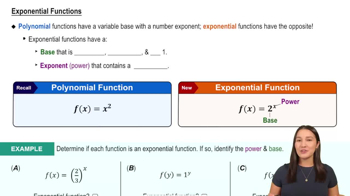Table of contents
- 0. Functions7h 52m
- Introduction to Functions16m
- Piecewise Functions10m
- Properties of Functions9m
- Common Functions1h 8m
- Transformations5m
- Combining Functions27m
- Exponent rules32m
- Exponential Functions28m
- Logarithmic Functions24m
- Properties of Logarithms34m
- Exponential & Logarithmic Equations35m
- Introduction to Trigonometric Functions38m
- Graphs of Trigonometric Functions44m
- Trigonometric Identities47m
- Inverse Trigonometric Functions48m
- 1. Limits and Continuity2h 2m
- 2. Intro to Derivatives1h 33m
- 3. Techniques of Differentiation3h 18m
- 4. Applications of Derivatives2h 38m
- 5. Graphical Applications of Derivatives6h 2m
- 6. Derivatives of Inverse, Exponential, & Logarithmic Functions2h 37m
- 7. Antiderivatives & Indefinite Integrals1h 26m
- 8. Definite Integrals4h 44m
- 9. Graphical Applications of Integrals2h 27m
- 10. Physics Applications of Integrals 2h 22m
4. Applications of Derivatives
Differentials
Problem 4.7.38
Textbook Question
17–83. Limits Evaluate the following limits. Use l’Hôpital’s Rule when it is convenient and applicable.
lim_x→ ∞ (e³ˣ ) / (3e³ˣ + 5)
 Verified step by step guidance
Verified step by step guidance1
Identify the form of the limit as x approaches infinity. The expression is (e^(3x)) / (3e^(3x) + 5). As x approaches infinity, both the numerator and the denominator approach infinity, which is an indeterminate form of type ∞/∞.
Since the limit is in the indeterminate form ∞/∞, we can apply l'Hôpital's Rule. This rule states that if the limit of f(x)/g(x) as x approaches a value is in the form 0/0 or ∞/∞, then it can be evaluated as the limit of f'(x)/g'(x), provided this new limit exists.
Differentiate the numerator and the denominator separately. The derivative of the numerator, e^(3x), with respect to x is 3e^(3x). The derivative of the denominator, 3e^(3x) + 5, with respect to x is 9e^(3x).
Apply l'Hôpital's Rule by taking the limit of the new fraction formed by the derivatives: lim_(x→∞) (3e^(3x)) / (9e^(3x)).
Simplify the expression by canceling out e^(3x) from the numerator and the denominator, resulting in lim_(x→∞) 3/9. Simplify this fraction to find the limit.
 Verified video answer for a similar problem:
Verified video answer for a similar problem:This video solution was recommended by our tutors as helpful for the problem above
Video duration:
2mPlay a video:
Was this helpful?
Key Concepts
Here are the essential concepts you must grasp in order to answer the question correctly.
Limits
Limits are fundamental in calculus, representing the value that a function approaches as the input approaches a certain point. They are essential for understanding continuity, derivatives, and integrals. In this context, evaluating the limit as x approaches infinity helps determine the behavior of the function at extreme values.
Recommended video:

One-Sided Limits
L'Hôpital's Rule
L'Hôpital's Rule is a method for evaluating limits that result in indeterminate forms, such as 0/0 or ∞/∞. It states that if these forms occur, the limit of the ratio of two functions can be found by taking the derivative of the numerator and the derivative of the denominator. This rule simplifies the process of finding limits in complex expressions.
Recommended video:
Guided course

Power Rules
Exponential Functions
Exponential functions, such as e^x, are functions where a constant base is raised to a variable exponent. They grow rapidly as x increases, which is crucial when evaluating limits at infinity. Understanding their growth behavior helps in determining the dominant terms in expressions, especially when comparing them to polynomial or constant terms.
Recommended video:

Exponential Functions







